Hand feeding baby rabbits
Hand-Raising Baby Rabbits - Feeding, Vaccinations & More
Hand-raising baby rabbits can be tricky and demanding, requiring a lot of time and dedication. This responsibility should never be taken lightly, and some points should be considered before deciding to hand-raise a baby bunny.
First and foremost, it is important to be 100% sure that the mother rabbit isn’t feeding the babies. Unless the mother rabbit is known to be deceased, there is a good chance that she is feeding her babies, even if it appears that she might be ignoring them.
A mother rabbit does not constantly tend to her babies the way we might think. Instead, they generally feed their babies only once or twice per day and then leave them alone, which is normal and natural behaviour. In the wild, a mother rabbit generally stays as far away from the nest as possible to avoid attracting predators to her babies. She will only revisit the nest to feed her young.
Signs of Neglect
If you think the mother rabbit is “ignoring” her litter, have a look at the babies. If the babies’ tummies are round and full looking, they are warm, their skin is not wrinkled, and they are sleeping calmly in the nest, then the mother rabbit is likely feeding them. If the babies are wrinkled, cold or have shrunken bellies, then this is a sign you may have to intervene.
Handling Newborn Rabbits
Before handling the babies, you must wash your hands well. This removes bacteria and eliminates any smells from other objects or animals that can stress the babies. Once your hands are clean, rub your hands in a bit of clean, fresh hay and on the mother rabbit’s fur to scent your hands.
Feeding Newborn Rabbits
Before starting any syringe or bottle-feeding, it is worth trying to get the babies to feed off their mum. There are a couple of ways to do this.
-
- Hold the mother over the babies in the nest to give the babies enough time to feed.
- Another option is to hold the mother rabbit on her back in your arms and gently try to put each baby onto a nipple to self-feed.
 Sometimes it is helpful for the babies if a small amount of milk is expressed from the nipple to entice the baby to suckle.
Sometimes it is helpful for the babies if a small amount of milk is expressed from the nipple to entice the baby to suckle.
If these two methods prove unsuccessful is not successful, then you may need to start hand-raising.
Providing Warmth
It is best to keep the babies in a warm, quiet place in a nest. Bunny fur is the best lining for the nest, but clean cotton wadding will do as a substitute. Just be sure the babies do not get tangled in it. For heating, two or more babies usually can snuggle and keep each other warm if they have a good nest. If there’s only one baby, a warm water bottle or heat pack wrapped in a soft towel can provide an excellent heat source however be sure the baby can crawl away if it feels too warm.
Formula and Feeding Supplies
We recommend using the Wombaroo Rabbit Milk as it is well balanced and contains a ‘milk oil’ equivalent which is important for baby rabbits. It comes as a powder that can be mixed with warm water to make milk for the babies. All the mixing instructions are on the box. Wombaroo Rabbit Milk can be purchased from The Unusual Pet Vets, some veterinary clinics and pet stores.
All the mixing instructions are on the box. Wombaroo Rabbit Milk can be purchased from The Unusual Pet Vets, some veterinary clinics and pet stores.
You will also need some small plastic syringes for feeding the milk to the babies. These are available from the Unusual Pet Vets, as well as some pharmacies.
You can also purchase small plastic feeding bottles and plastic teats from some large pet shops; however, you will need to buy the smallest teat possible as usually the puppy and kitten ones are too big. Most baby rabbits will feed from a syringe without a problem.
A small set of scales to weigh the baby rabbits will also be required. The amount of milk to feed is dependent on the baby rabbit’s weight. There is a weight chart on the Wombaroo Rabbit Milk box and the mls of milk to be fed over 24 hours. How much the baby rabbit will take in one feeding session depends on how frequently you have the feed them.
Feeding Procedure
When feeding, it is important to prevent aspiration (inhalation) of the formula by the babies. The smallest drop of formula in the lungs can cause fatal pneumonia within a few hours. The following instructions provide a step-by-step feeding guide:
The smallest drop of formula in the lungs can cause fatal pneumonia within a few hours. The following instructions provide a step-by-step feeding guide:
Step 1
Make sure all your syringes and bottles have been washed before use.
Step 2
Baby rabbits can be wiggly and unpredictable, so ensure they are fed in a safe place where they cannot fall.
Step 3
Hold the baby upright (or in some cases on their back gently) in one hand and the bottle/syringe in the other.
Step 4
Babies often resist feeding at first, and you must overcome the temptation to force-feed. If the baby doesn’t accept the teat or syringe, then wet the baby’s lips with a drop of warm formula so they will hopefully lick it off. Once they have swallowed that, repeat the procedure over and over. Be persistent and gentle. In most cases, the baby will soon learn about feeding time and take the formula willingly though they may not do this on the first feeding.
Step 5
Do not be too forceful and squeeze too much formula into the baby rabbit’s mouth. They can aspirate milk quite easily, so only drip the formula slowly for the baby to lick up.
They can aspirate milk quite easily, so only drip the formula slowly for the baby to lick up.
Step 6
If the baby grabs the teat and begins suckling, allow them to do so without adding any pressure yourself. The baby should be able to suckle with enough strength to empty the bottle or syringe without any help from you. If you provide extra force, the baby may accidentally aspirate formula that’s coming in too fast.
Step 7
If the baby does not suckle, it’s generally not a major problem. Most will learn to lap/sip from the tip of the teat, and this is safer in many cases as it does reduce the risk of aspiration. Try to hold the teat/syringe tip sideways or down-pointed (so the plunger is lower than the tip) relative to the mouth to further reduce the risk of aspiration.
Step 8
Until they open their eyes, handle the babies as little as possible when you’re not feeding.
Urination and Defecation
Many newborn mammals cannot urinate/defecate on their own. Many baby bunnies will require the stimulation of the mother’s grooming tongue on their bellies and genital region in order to release a stream of urine and faeces. If you are hand-raising, then you will need to try to mimic this behaviour. To do this, use a cotton ball moistened with warm water, and gently tap/rub the urogenital area until you feel the baby’s abdominal muscles tense and release a stream of urine or pass faeces. Getting this response may take 15-20 seconds of stimulation, or even more in some cases.
Many baby bunnies will require the stimulation of the mother’s grooming tongue on their bellies and genital region in order to release a stream of urine and faeces. If you are hand-raising, then you will need to try to mimic this behaviour. To do this, use a cotton ball moistened with warm water, and gently tap/rub the urogenital area until you feel the baby’s abdominal muscles tense and release a stream of urine or pass faeces. Getting this response may take 15-20 seconds of stimulation, or even more in some cases.
Baby rabbits’ eyes open at about 10 days of age. Once this occurs, you can gradually introduce them to timothy and oaten hay, pellets, small amounts of green vegetables, and water in a shallow dish.
By 2 – 4 weeks of age, normally, baby rabbits will start eating their mother’s caecotrophs to keep their gastrointestinal tract full of good bacteria. If you have access to the mother rabbit or another healthy rabbit’s caecotrophs – mix them with some formula or some warm water and syringe feed this to the babies.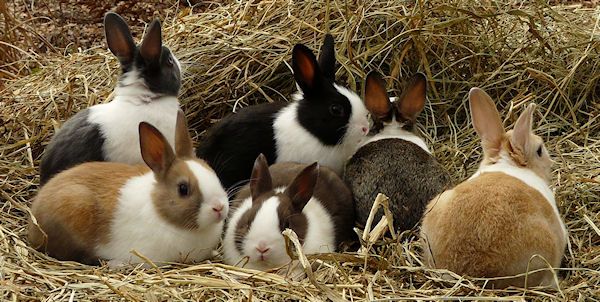 It is good to repeat this 2 or 3 times over a 2 – 3 week period to help them establish normal gastrointestinal flora.
It is good to repeat this 2 or 3 times over a 2 – 3 week period to help them establish normal gastrointestinal flora.
Weaning
A mother rabbit feeds her babies for about 3 – 6 weeks, gradually decreasing the frequency of feedings until they lose interest. Your baby bunnies will start to nibble solid food at about the age of two to three weeks, but this does not mean they are ready to be weaned.
If the babies still beg for nursing by the age of 6-8 weeks, you can begin to dilute the formula with clean drinking water to help the weaning process. Start with 25% water to 75% formula, and gradually decrease the percentage of milk until the babies lose interest.
Baby rabbits can then be rehomed to new families by 8 weeks of age, as long as they are fully weaned and eating solids well on their own.
Vaccinations
Baby rabbits should then be vaccinated against Calici Virus when they are eight weeks old, then a booster is required four weeks later, and then bi-annually from then on.
Sterilisation
Rabbits can generally be sterilised from 4 months of age for males and 5 months for females. Male and female baby rabbits should be separated from each other by 10 – 12 weeks of age to prevent any early pregnancies.
If you have any further questions, please don’t hesitate to get in touch with us or book an appointment with a rabbit vet.
How do I hand-feed a baby rabbit?
Hand-feeding a baby rabbit is not for the faint of heart. In fact, the job is very time consuming and is harder to do that what it may seem to be. Not only do you need to know what to feed them, you must also know what the correct amount is for each stage of growth. While under feeding will cause them to starve to death, over feeding them can cause pain and gas, making the baby sick. As you continue to read this article, we will provide the answers that you need to successfully hand rear bunnies.
Bottle options
Choosing the correct bottle is as important as having the correct formula to put into the bottle. For novices, the choices can be confusing. The typical pet-nursing bottles that are sold for kittens and other small animals, but that is not the end-all be-all options you have to work with. There are various types of Syringe feeders, Q-Tips, and sponges. There really is no right or wrong option; however there are right and wrong ways to use each of them.
For novices, the choices can be confusing. The typical pet-nursing bottles that are sold for kittens and other small animals, but that is not the end-all be-all options you have to work with. There are various types of Syringe feeders, Q-Tips, and sponges. There really is no right or wrong option; however there are right and wrong ways to use each of them.
1. PET NURSING BOTTLES: These can be bought at very low prices, in most stores which offer pet supplies. The important thing to note is the nipple size and the fact that you have to make the hole in the tip of the nipple. If you make the hole too large, the babies can get too much formula and possibly aspirate. On the other hand, if you make the hole too small, the babies may not be able to get enough formula and will, essentially, starve to death. Therefore, the best method is to use a pair of (tiny, very sharp) fingernail scissors. Push the tip of the scissors up thru the “inside” of the nipple, and continue pushing until half of the blades are pushed thru and out of the tip.
When you pull the scissors out, pinch the tip of the nipple to expose the cut area, and then working from the outside, using the center of the cut as your center-point, snip an “X” into the nipple. This may need to be repeated to get the hole to produce an effective amount of formula. You will ‘have it right’ when you test the cut. To do this, put water in the bottle, replace the top and nipple, and hold it at a 60-80* downward angle. Pinch the end of the nipple with mild to moderate pressure. If a droplet easily comes out, you are in good shape. If water comes out without the need of pinching the nipple, your hole may be too large. And if there is no droplet or if it requires you to pinch hard and only results in a small drop, then your hole is too small.
You might also like: How to care for a rabbit? 10 Steps!
2. Q-TIPS: These are readily available at most any store, and cheap. This option may be best and easiest to use for newborn babies.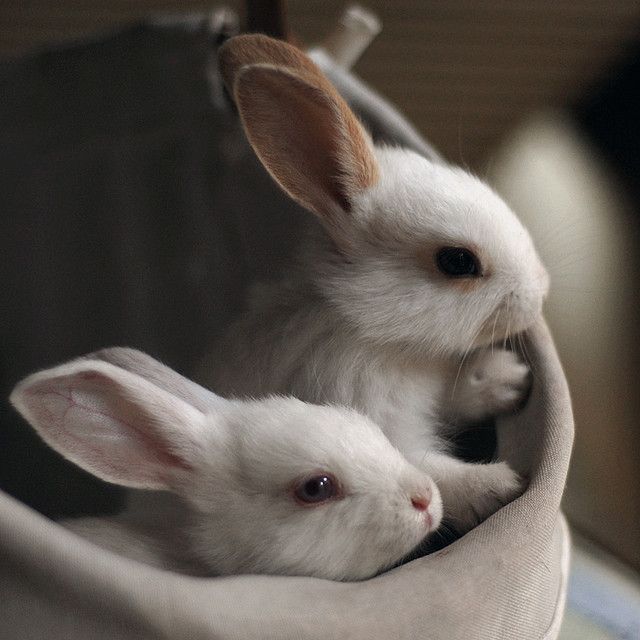 You will want to use the type with rounded tips, not the pointed type that are made for make-up applications. There are two ways to use a Q-tip to feed with. The first method is to dip the cotton-end of the q-tip into the formula and allow the baby to suck the formula off of it, then re-dip and repeat. It may take a few tries to get the baby to understand that it is being fed this way, so don’t be too forceful, but keep trying until he gets the hang of it. The next method is to cut a q-tip in half and insert the stick end into the end of a syringe.
You will want to use the type with rounded tips, not the pointed type that are made for make-up applications. There are two ways to use a Q-tip to feed with. The first method is to dip the cotton-end of the q-tip into the formula and allow the baby to suck the formula off of it, then re-dip and repeat. It may take a few tries to get the baby to understand that it is being fed this way, so don’t be too forceful, but keep trying until he gets the hang of it. The next method is to cut a q-tip in half and insert the stick end into the end of a syringe.
Note that the syringe will need to snuggly hold the stick, or formula will just pour out when you try to use it to feed with. Otherwise, when using this method, you will need to be sure the q-tip has the plastic, hollow type sticks. This allows you the option of putting the formula into the syringe and allowing it to flow down and soak the cotton, therefore eliminating the need to continually dip the q-tip into the formula so many times.
3. SPONGES: Buy a pack of make-up wedge sponges. Dip the thin end into the formula, and use the corner edge for the baby to suckle from. This is a better option than the q-tip dipping method in regards that you don’t have to continually dip the sponge. Instead, once the baby has drained the formula from it, you can put more formula on the center of sponge with a dropper, which will then be absorbed down into the tip the baby is nursing from.
4. SYRINGES: Syringe feeding can save a lot of time, however the type of syringe you use will play an important role in how the formula will be accepted.
(A) Rubber Ear Bulb Syringes work very well for this, as the tip of the syringe and the stick of the q-tip are relatively a good fit, although you will still need to “push” the stick into the syringe so that it is snug and will not be easily removed from the baby while suckling from it. One notable caution is to pay attention to the cotton. If the baby chews it and frays the fibers apart, you will want to switch q-tips to a new one; to prevent the baby from swallowing the stringy fibers which might cause choking or GI problems such as Wool Block.
If the baby chews it and frays the fibers apart, you will want to switch q-tips to a new one; to prevent the baby from swallowing the stringy fibers which might cause choking or GI problems such as Wool Block.
(B) Sponge-Syringes can be used in similar method as described above. If opting for this method, you would push the end of the syringe into the wider/thicker end of the sponge about half-way down into the sponge. The notable caution with this method is also as described above; being careful to watch that the baby doesn’t chew any bits of the sponge off, which could result in choking or GI problems.
(C) Slip-On Nipple Syringes would be your other choice. These can be used with several types of feeding tips, from silicone tube to nipple. One of the more popular types is called a “Miracle Nipple”, which slips over the end of a slip-tip and luer-lock syringe as well as small pet bottles, and offers a pre-made hole in the tip (available on Amazon).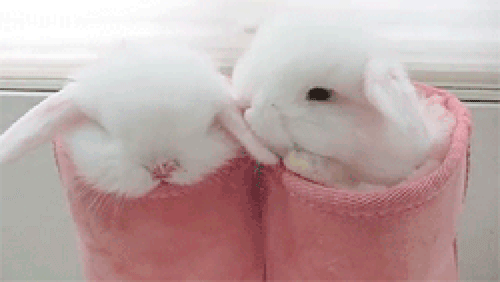
Baby Formula
Now that we have covered the container options, let’s look at what you will need to put into the bottle. There are several milk replacers, including kitten formula that can be used safely when feeding orphaned bunnies. However, the best option is Goats Milk, which can often be found in the dairy section of your local grocery or Health Food type stores. Next, you will need Heavy Whipping Cream; also available in the dairy section of your local grocery store. And then you will need Colostrum. The most commonly used form is the powdered “Kid Colostrum” for Goats, which can be found at most feed-supply stores. Once you get these items home, you will need to gather up a few tools: A container with a lid that closes (such as a Water Bottle) for mixing and storing, a small bowl and coffee cup, ½ cup measuring cup, and measuring spoons at 1 Tablespoon and ½ Teaspoon. Now, you will want to put the formula mixture into the mixing/storing container. Here is the recipe: ½ Cup Goat Milk, ½ Teaspoon of Heavy Cream, and 1 Tablespoon (or 10 emptied capsules, if using that form) of Colostrum. Now in your coffee cup, fill half full of water and microwave for 1-3 minutes, or until the water is at a low boil. While waiting on the water to heat, close the container with the formula and shake vigorously for several minutes. Once the water is hot, pour a small amount of the formula into a the small bowl.
Now in your coffee cup, fill half full of water and microwave for 1-3 minutes, or until the water is at a low boil. While waiting on the water to heat, close the container with the formula and shake vigorously for several minutes. Once the water is hot, pour a small amount of the formula into a the small bowl.
(Tip: A washed out single-snack size yogurt cup works great!)
Then place the small bowl of formula into the hot water. This will heat the formula without scorching it, while allowing you to have a more consistent watch on the temperature of the formula. As you would with an infant child, you want the formula to be room temperature or luke-warm. The babies will not drink cold milk, and if it’s too hot it could cause them to be burned.
Feeding the babies
When feeding baby rabbits, there are several things that should be noted. First of all, the babies only need to be fed twice daily – morning and night. And after every feeding, for at least the first 2-3 weeks, each baby will have to be stimulated to potty. It is easily done! Just gently rub or pat the genital/anal area with a warm, soft cloth; however, failure to do so could be fatal. Otherwise, here is a simple chart to show you the amounts that baby bunnies should be fed.
It is easily done! Just gently rub or pat the genital/anal area with a warm, soft cloth; however, failure to do so could be fatal. Otherwise, here is a simple chart to show you the amounts that baby bunnies should be fed.
0-1 week of age: 2 – 3cc per baby
1-2 weeks of age: 4 – 7cc per baby > resist over feeding and do not allow the baby to eat too fast, as this could result in aspiration or gas build up
2-3 weeks of age: 7 – 14cc per baby > start introducing hay
3-6 weeks of age: 14 – 17cc per baby > gather a cecotrope from any healthy, parasite free adult rabbit and mix it into a small amount of the formula for 2-3 consecutive days; may need to syringe-feed this as most babies do not like it and will often try to refuse to eat it… this is an important step in establishing healthy flora in the babies guts. *After this cecotrope introduction, you can also begin offering small amounts of pellets to the babies.
Help! My baby bunny is aspirating
One of the most common forms of death by hand-fed baby animals is due to aspiration. This is the term used for a baby who failed to correctly swallow formula. The liquid gets into the lungs and quickly, the baby “drowns” and dies very quickly while you watch helplessly. But guess what! You CAN save your baby. This is how: place the baby, lengthwise, on the palm of your hand (head at fingertips, tail at wrist) and close your other hand securely over the baby, so that you are cupping it in your hands. Now, standing up, raise your hands to chest level and swing downwards, between your knees. Do this swiftly, but not harshly, and be very careful not to drop the baby. Doing this acts like doing the Heimlich Maneuver, causing the fluid to be forced out and restoring the ability to breath.
Feeding baby rabbits: features, tricks, tips
Mother feeding for the most part falls on the first three weeks of life of baby rabbits. Find out what to do if an unforeseen situation happens and the babies are left without a mother.
Find out what to do if an unforeseen situation happens and the babies are left without a mother.
From three to six weeks old, baby rabbits need less milk and more pellets and hay. During the period when the rabbits no longer need mother's milk, they are weaned.
The physiologically reasonable weaning age is 3.5‒4 months and if you have a rabbit of this age at home, you can immediately give him roughage, additional milk feeding is used only if he suffers from malnutrition. At home, the rabbit is allowed to nurse her babies longer - up to the age of 6-7 weeks.
Loss of a nurse
Sometimes unforeseen situations happen - the death of a female or mastitis, aggressive behavior or refusal to feed the cubs. Whatever the reason, from now on, the care of the rabbits falls entirely on the shoulders of a person.
Further actions depend on the age of the rabbits and the presence of another female who can be entrusted with feeding them. Read this article to learn how to properly transfer babies to a foster mother.
Read this article to learn how to properly transfer babies to a foster mother.
If it is not possible to transfer the cubs to another female rabbit, they are artificially fed and some important points must be taken into account.
As sad as it is to admit, the survival rate of motherless rabbits, if their eyes have not yet opened, and this is the age of 10-12 days, is very low. Mortality with inexperienced care can reach 80-90%. This means that out of ten rabbits, one or two survive.
There are many reasons for this catastrophic mortality rate, the main ones being:
Before rabbits begin to eat roughage, there are no bacterial populations in their intestines. If, during artificial feeding with milk formula, bacteria that are abnormal for rabbits of this age are introduced into the body, which can be caused by dirty hands or unsterilized nipples and bottles, this causes severe intoxication and indigestion. Diarrhea is one of the most common causes of death in rabbits.
If, during artificial feeding with milk formula, bacteria that are abnormal for rabbits of this age are introduced into the body, which can be caused by dirty hands or unsterilized nipples and bottles, this causes severe intoxication and indigestion. Diarrhea is one of the most common causes of death in rabbits.
Feeding supplies
Buy plastic teat bottles first. Since they are usually sold in pairs or as a set of a bottle and several nozzles, it is important to find the smallest nipples, and which bottle is not a big deal.
If you can get special teats for rabbits, great, if not, kittens will do. As one of the components, a milk replacer for kittens is introduced into the formula for feeding rabbits, and some manufacturers include a bottle with nipples in such a set, which is quite convenient.
Keep in mind that pet sellers often refer to rabbits as rodents or animals. So look for the products you need in one of these sections.
Special plastic syringes with silicone or rubber tips are successfully used.
As an exception, try using a regular eyedropper or eye dropper bottle.
Successful rearing of young rabbits is not an easy task. Rabbits have a complex digestive system, and babies are even more vulnerable. Below is a universal formula formula for suckers of all ages.
For preparation take:
- fresh whole goat milk - 100 g
- kitten milk replacer - 100 g
- colostrum (lyophilized colostrum) - 10-15 capsules (1-1.5 tablespoons)
Colostrum is an expensive ingredient, but it is almost impossible to raise very small rabbits without colostrum.
Place all components in a glass container, close tightly, then shake vigorously until the contents turn into a homogeneous mass.
Prepare new formula before each feeding. If there are few cubs, you can reduce all components proportionally.
Heat the mixture to 40 °C, it is convenient to check the temperature with a regular thermometer, wipe it with alcohol before use.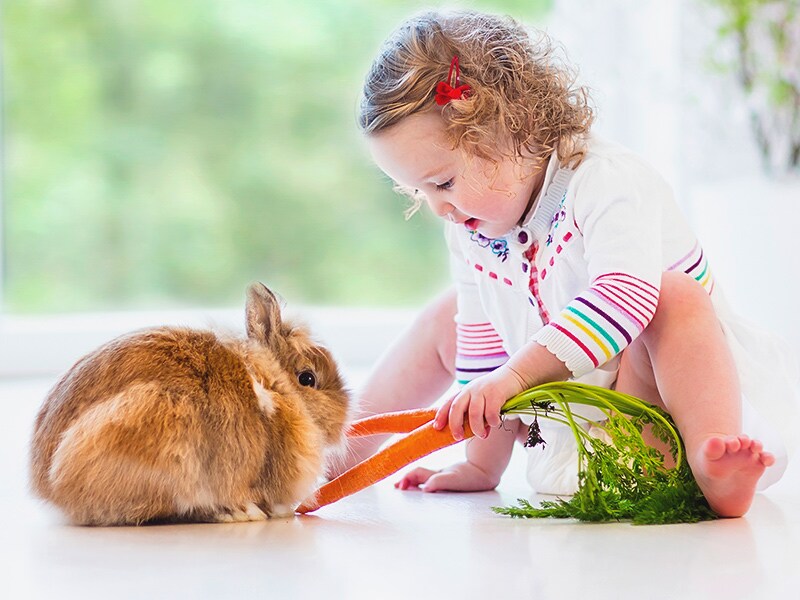 Keep cooked food in hot water until you have fed all the babies.
Keep cooked food in hot water until you have fed all the babies.
For older rabbits (from 14 days old), add up to 1 teaspoon of quality cow's milk cream to the mixture.
Do not use condensed milk - excess sugars, prolonged heat treatment, vegetable fats and other components unusual for natural milk - all this will lead to the fact that the product can do more harm than good.
Cow's milk is inferior in nutritional properties and digestibility to goat's milk, moreover, it has less antibodies and larger fat globules, so it is undesirable to use it for feeding rabbits.
Feeding procedure
Remember, the most dangerous thing that can happen to young rabbits during feeding is inhalation of the mixture. This will lead to instant aspiration when the baby stops breathing and passes out, or to the rapid development of pneumonia. Therefore, when feeding, do not rush, do everything carefully, be leisurely, be patient and follow the steps below.
1.
 Cleanliness of dishes
Cleanliness of dishes Disinfect syringes, nipples and bottles in a special steam sterilizer or by boiling water.
2. Hand hygiene
Wash hands in hot running water with laundry soap (toilet soap is not used due to strong odor) and dry thoroughly.
3. Precautions
When feeding older rabbits, lie on the floor - swift fidgets can jump out of your hands in no time. Place a towel on your knees. Wrap the bottle in flannel, the cub will rest on it with its front paws, as if it were fed by a rabbit, besides, the milk will not cool down.
4. Feeding
Hold the baby in one hand and the bottle in the other. Hold the baby horizontally with the tummy down, in the most natural feeding position, you can slightly lift the front or turn the baby to the side. Successfully feed rabbits in an upright position. No need to lay the sucker on his back - he can choke. It is enough to simply hold the grown-up rabbits with your hand, avoiding choppy movements.
6. Patience
Rabbits, especially very small ones, often stubbornly refuse to suckle, some may take a day or two for the sucking reflex to develop.
It's not surprising that you might want to force-feed the little stubborn one. Don't do this under any circumstances! Be persistent, but be gentle and careful, squeeze out some of the mixture, moisten your mouth and continue to bring the pipette or nipple to it with a drop of milk, encouraging you to lick off the mixture.
Continue like this until the bunny begins to suck on its own. Sometimes it may take several feedings to be successful. If he grabs the nipple and starts sucking, let him eat at his own pace - no need to squeeze the bottle.
What should I do if my rabbit has inhaled the formula and is not breathing?
If a baby rabbit inhales milk formula, drops of it can cause complete blockage of the airways and fainting. Therefore, you need to act very quickly and take urgent resuscitation measures.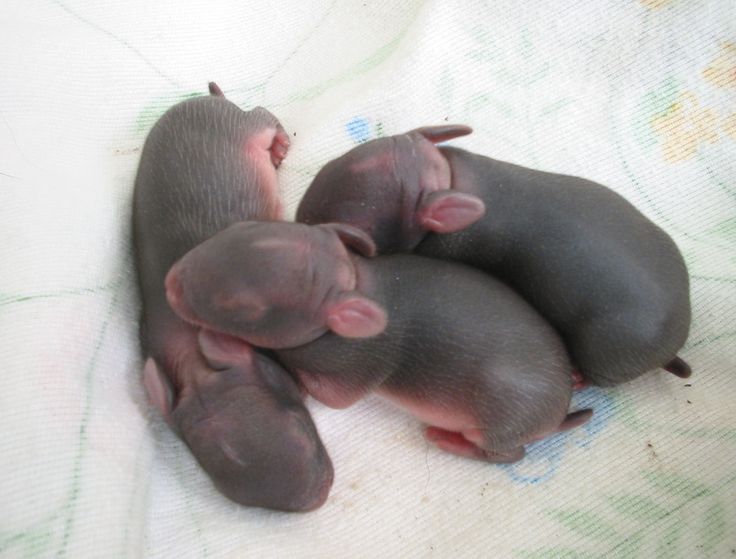
Hold the rabbit in both hands, head up, with the palms of your hands firmly on the back and neck, but without squeezing too much. Raise it above your head and lower it down to the floor, moving not very fast, but with determination. Repeat the reception two or three times. The rabbit's insides will rush upward as they move down and push the diaphragm, which may be enough to push air and mixture particles out of the airways. As soon as the rabbit moves, stop immediately.
You will most likely need to administer antibiotics to prevent pneumonia, please consult your veterinarian about prescribing the drug.
Amount of servings, frequency and features of feeding
0–7 days
Newborn rabbits are fed twice a day, in the amount of 2–2.5 ml of milk formula at each feeding.
Very small rabbits will not be able to recover on their own. The female rabbit, while caring for the sucklings, licks them, stimulating muscle contraction, which facilitates urination and defecation.
To prevent overfilling of the bladder and intestines, take the following technique into service.
Rub the tummy, including the anus, with light but firm strokes, as a female rabbit would do. Your task is to stimulate the tension of the abdominal muscles.
The procedure is performed with a finger moistened with warm water, you can wrap it with a damp cloth or use a moistened cotton swab. Manipulation will take from 15-25 seconds to two minutes and you need to continue it until the bladder is empty.
Some breeders find it best to do this before feeding and great if it works, but the extra pressure of a full belly can speed up and ease the process.
Be careful and persistent, sometimes rabbits cannot empty their intestines and bladder without light massage for quite a long time - up to a few weeks of age. Do not rub too hard as this can cause redness and irritation of delicate skin. If redness is still present, use a soothing calendula ointment.
8-14 days
The norm for this period is two feedings per day, 5-7 ml each time.
Don't overfeed your rabbit! Once he understands how the system works, he will eat as much as you give. He may eat so much formula that the tummy will stretch, causing discomfort, indigestion and gas.
It is better to underfeed a gluttonous baby than to overfeed. Well-fed rabbits look round and plump, but not like tumblers with stretched tummies.
In addition, it is important to take into account that the receptors that signal satiety do not work instantly and it takes some time. If the bunny looks hungry and you're not sure he's gotten enough food, wait a minute or two and offer the pacifier again, maybe he won't pounce with the same greed now.
15-21 days
Still two main feedings - 7-13 ml at a time.
By this time the eyes are already open and the rabbits begin to take an interest in what is happening around, including coarse food.
Timothy or oat hay, rabbit pellets and fresh water should now be constantly present in the cage. Rabbits are offered water not in an automatic drinker, but in a shallow bowl or bowl.
Rabbits are offered water not in an automatic drinker, but in a shallow bowl or bowl.
Experienced breeders recommend, even before the moment when the rabbits begin to consume roughage, to artificially introduce beneficial microflora into the body.
To do this, choose a donor - a healthy adult rabbit, not infected with helminths, and take some fresh caecotrophs from him (read about what it is here).
The resulting balls are kneaded, mixed with a small amount of milk mixture and fed to the rabbit, who, of course, will not be delighted with such food. Treat this event like giving medicine. This technique will make it possible to populate the rabbit's intestines with healthy microflora, and besides, caecotrophs contain many useful substances. Such an introduction of microflora for 2-3 days will be quite sufficient.
You can replace caecotrophs with probiotics, such as the German Olin or the domestic Zoonorm.
22-42 days
Two feedings of 13-15 ml at a time, the amount of servings may be smaller, depending on the breed and development of the rabbit.
At this time, alfalfa or clover hay is introduced into the diet, as well as granules with a high protein content - 16-18%. You can additionally introduce some sunflower seeds or whole oat grains.
Weaning
A female rabbit feeds her young at home for up to eight weeks or more, gradually reducing the frequency of feedings until the young rabbits lose interest. As early as two weeks, rabbits will begin to gnaw on pelleted food and taste hay, but this is not a reason to stop feeding them a mixture. On the contrary, during this period, in no case should you stop the main feeding.
Colostrum containing useful antibodies will help the rabbits to control the development of microflora, and restrain the growth of potentially dangerous colonies.
From 6 to 8 weeks of age, start diluting formula with clean drinking water. Start by adding a quarter of water, gradually bringing the composition to this proportion: three quarters of water - one part of the mixture. The rabbits themselves will lose interest in feeding, and weaning will not be as traumatic.
The rabbits themselves will lose interest in feeding, and weaning will not be as traumatic.
Tell us about your experience with baby rabbits. Your knowledge and practical experience are really important and can save a baby's life. Post your recommendations in the comments below or send your material to the Our Stories section.
Social buttons for Joomla
milk substitutes, feeding, newborn care
Sometimes it happens that the young rabbits, barely born, are left without mother's milk and care. Then these worries fall on the shoulders of a person. Feeding rabbits without a rabbit is a serious and responsible matter, because the life of babies depends on the speed of decision-making and subsequent actions.
Why are baby rabbits left without mother's milk and care? What is the danger?
The decision in favor of artificial feeding is made by the farmer for one of the following reasons:
- as soon as she has calved, the female refuses the young rabbits and abandons them;
- the female rabbit has no milk or has developed mastitis;
- the female is in a very serious condition after birth or she has died;
- other nurse does not accept babies.

It is especially dangerous for young rabbits when the female dies without having time to feed them with valuable colostrum for the first time. It contains antibodies necessary for babies, which contribute to the development of their own immunity.
Human care and care will not replace mother's cubs, and incorrect actions on the part of breeders increase the mortality rate.
Ornamental rabbits are less likely to survive, and meat breeds, even when bottle-fed, grow up to be healthy, strong individuals.
What to try before artificial feeding?
The purpose of artificial feeding is not only to ensure the satiety of rabbits, but to provide comprehensive care for offspring. Please try the following alternatives before you begin your duties:
- Find a litter nurse. This course of events is possible if the breeder has several queens. You can’t just plant baby rabbits with another lactating female. There is practically no chance that she will accept someone else's offspring.

Therefore, remove the rabbit for half an hour in another cage, and wipe the babies with fluff and straw from her dwelling. The nurse will return to the cage and will probably take on new wards. - Awaken the parental instinct. Most often, it is after the first birth that a mother does not want to feed her babies. Try to solve this problem by simply holding the rabbit during several feedings.
With a favorable outcome, feeding on mother's milk, the rabbits will quickly get stronger and begin to gain weight. But it happens that these tips do not help.
How to properly feed baby rabbits for the first 30 days?
Baby rabbits are born completely blind, without wool. The first fluff on the body begins to grow on the 6th day, and the opening of the eyes occurs on the 10th day. Newborns weigh 60-90 g, but with comprehensive care and good nutrition, they quickly gain weight and grow.
The farmer should prepare for artificial feeding of the offspring - master the skills of care and purchase equipment.
Tools
Baby rabbits require teats and containers.
Buy Animal Feeding Kit from the shop. It includes a special syringe with rubber nozzles of various shapes and sizes. Such a set is sold in the form of a bottle with several special nipples.
You can get by with improvised means:
- Use the syringe and the pipette rubber cap to feed, poke a few small holes in it.
- eye drop bottle is suitable for the procedure. For convenience, use it together with a pipette tip.
- Small baby bottle is useful for older animals.
The process of artificial feeding should be as close as possible to natural.
Before opening their eyes, the reaction of rabbits to teat substitutes is weak. When pouring milk into the mouth, be careful and do not rush, otherwise the rabbit may choke or choke.
Milk replacers
Newborn baby rabbits require high quality nutrition. Rabbit milk substitutes include:
Rabbit milk substitutes include:
- Goat milk. The best option for artificial feeding of rabbits. There is no need to dilute or add anything, because the composition is similar to rabbit milk, only slightly inferior to it in fat content.
- Cow's milk. The most affordable and common alternative to rabbit milk. In its pure form, it cannot be fed to babies, because it lacks carbohydrates in its composition. Mix cow's milk with condensed milk in a ratio of 3:1. Heat the mixture for 40-60 minutes. at a temperature of 70. Before feeding, cool to 37 degrees.
- Special blends. Sold in pet stores and veterinary pharmacies in a large assortment. Buy milk substitutes designed for rabbits or dogs. In a pinch, suitable food for cats. In terms of components, their composition is as similar as possible to rabbit milk.
- Infant formula . Such food is suitable for rabbits if it contains a minimum of sugar and additives.

In the presented video you can see the principle of artificial feeding of rabbits:
Thus, the most suitable food for newborn rabbits is special dry mixes, and cow's milk is the least preferred option.
Feeding procedure
During the procedure, hold the animals upright, firmly, but without crushing. At first, rabbits may not respond to simulated nipples. Be patient.
Gently moisten your baby's mouth with milk, he will lick it off himself. Repeat several times. This will stimulate the sucking reflex.
During the feeding procedure, be careful not to get liquid into the animal's respiratory tract. This is fraught with the death of the rabbit.
Make sure that the tummy does not overflow, because babies themselves can not yet determine the level of their satiety. Overeating causes indigestion and related problems.
Overeating causes indigestion and related problems.
Feeding liquid should be 37 degrees. Store milk for up to 3 days in the refrigerator, and always use freshly prepared formula for feeding.
Adjust the diet according to the needs of the cubs. Well-fed babies sleep quietly, and hungry babies squeak and actively look for a source of food.
Dosage and frequency
The amount of mixture and the frequency of feeding are directly dependent on the age of the rabbits.
The female feeds the young rabbits 1-3 times a day. Her milk is very nutritious, so many feeding sessions are enough for rabbits for proper development, growth and weight gain.
But none of the formulas can replace the rabbit's milk, so bottle-fed babies are fed up to 6 times a day.
In the first 2 days, the rabbits need a few drops of food per dose, even 1 ml of the mixture is too much for them.
Gradually, the amount of milk needed for the development of the cubs increases, and the number of feedings decreases.
Artificial feeding by age
Organizing artificial feeding is a responsible business. You need to be extremely careful when choosing a diet for rabbits, depending on their age and physical health. After all, errors in the quantity and quality of the diet adversely affect the cubs.
From birth to 5 days
A newborn baby rabbit needs 1 drop of nutrient fluid. For the first day they feed 5-6 times. Since babies have not yet learned to swallow on their own, care must be taken.
On the second day, 4-5 meals are enough. On the 5th day - 4 feedings. The daily norm of milk is 5-6 ml. By the end of this period, rabbits with normal development double their weight.
From 6 to 14 days
Animals grow up and the amount of nutrient mixture per feeding increases. They drink 7-10 ml of milk per day. The number of feedings remains the same, or decreases to 3. The weight of the rabbits reaches 250 g.
From the 15th to the 30th day
From the 15th day the animals are transferred to two meals a day. In the first 2-3 days, observe the behavior of the young and, if signs of hunger are present, supplement them with a small amount of formula in the 3rd feeding.
In the first 2-3 days, observe the behavior of the young and, if signs of hunger are present, supplement them with a small amount of formula in the 3rd feeding.
The amount of the mixture per day by the end of the month reaches 60 ml. While this is their main food. Weaning from the nipple should be on the 20-25th day.
The readiness for the introduction of complementary foods is determined by the condition of the teeth. If the molars have replaced the milk teeth, then solid food can be gradually introduced and taught to drink from a saucer.
Weight of animals by the end of the period reaches approximately 500 g.
Starting from the third week, put small piles of dry grass in the cage - this will prepare the rabbits for solid food.
At this time, it is important to monitor the change in the baby's stool. Remove hay from the diet immediately if diarrhea occurs. If adaptation to new food goes without problems, then add a small amount of compound feed, grass, carrots.
Remove hay from the diet immediately if diarrhea occurs. If adaptation to new food goes without problems, then add a small amount of compound feed, grass, carrots.
From the 31st day, if there is no shortage in weight, milk is gradually removed from the diet of rabbits. When the offspring are 45 days old, their diet completely switches to an adult.
Vitamin A and Vitamin D
In nature, baby rabbits get their vitamins and minerals from their mother's milk and then from a varied adult diet. Artificially fed individuals need more vitamin supplements.
If the body lacks vitamin A , then rabbits suffer from a runny nose and dry eyes. This vitamin is responsible for the desire to reproduce and have healthy offspring, as well as the healthy functioning of the nervous system. Its sources are: beet tops, carrots, cabbage leaves, young grass, etc.
Vitamin D is responsible for bone formation. With its lack, growth retardation and various deformities of the limbs and spine are possible.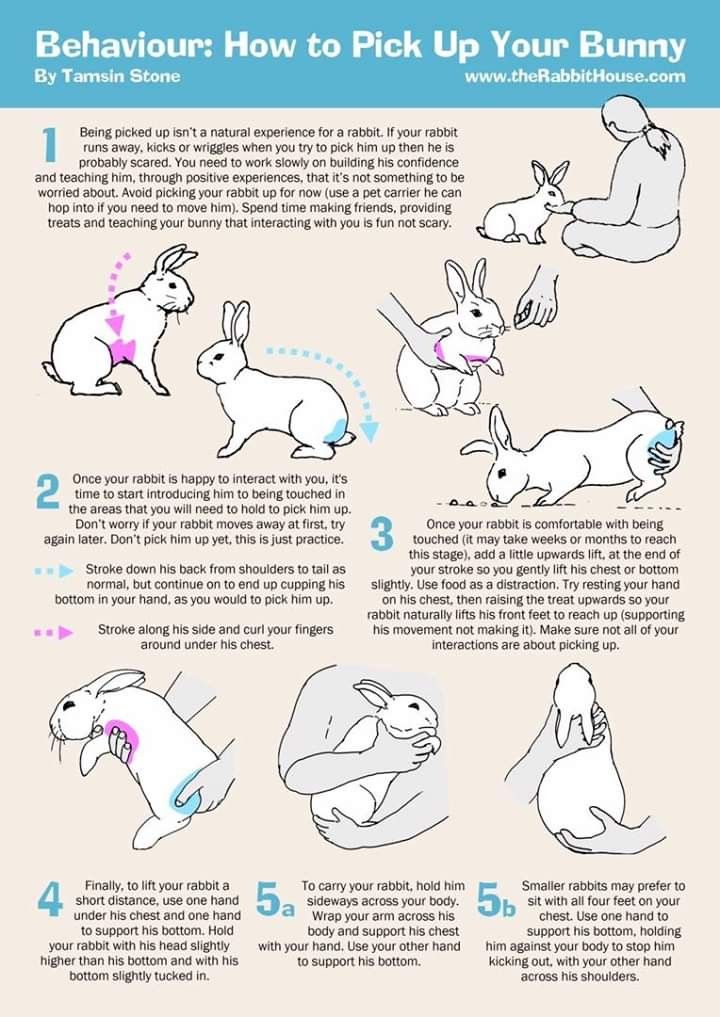 Vitamin D is produced by the body itself under the influence of sunlight. This will help bone meal, fish oil, milk. Feed food in places where the sun's rays do not have access, because under their influence vitamin D is destroyed.
Vitamin D is produced by the body itself under the influence of sunlight. This will help bone meal, fish oil, milk. Feed food in places where the sun's rays do not have access, because under their influence vitamin D is destroyed.
Oatmeal and oat sprouts
Oats are a fundamental grain in rabbit nutrition, containing a storehouse of vitamins and microelements. Its calorie content is 336 kcal/100 g. It can take up to 50% of the total mass of feed. Rabbits on such feed gain weight well, but oats do not cause obesity.
This cereal is introduced into the diet of rabbits as soon as they begin to feed on their own. First, they are fed with oatmeal or crushed grain, and later they switch to feeding with whole grains.
Animals eat such food with pleasure up to 5 times a day, and adults - 3 times a day.
Oat seedlings have a good effect on the reproductive system of rabbits. For mating, it is introduced into the diet of both males and rabbits. Oats help lactating females recover after birth and stimulate the production of nutritious milk.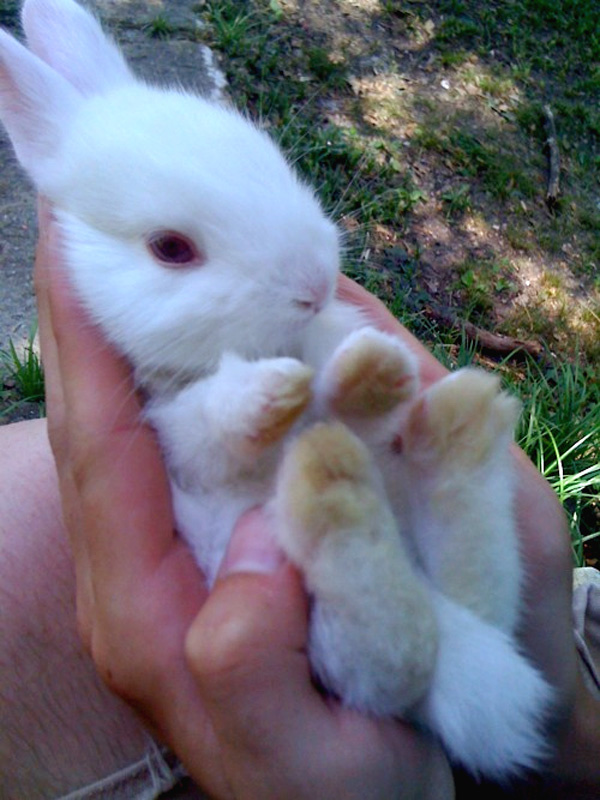
Useful substances, which are rich in sprouted oats, have a beneficial effect on the gastrointestinal tract of animals. Appetite increases, fur becomes beautiful and shiny, body weight grows.
Be sure to include a water bowl in the cage if the rabbits diet is dominated by dry cereal food.
Bone meal and chalk
Bone meal is a powder from the bones of animals and birds, the most valuable source of calcium, phosphorus, fluorine, zinc, iron, protein and other micro and macro elements.
By introducing it into complementary foods, the likelihood of diseases associated with the musculoskeletal system in rabbits is significantly reduced. Thanks to proteins, the muscle mass of animals grows faster.
The doses indicated on the packaging of bone meal must be strictly observed. An overdose is even more dangerous than the problems associated with the absence of this bait:
- The stomach of rabbits becomes clogged with a jelly-like mass, because of which the animals often die.
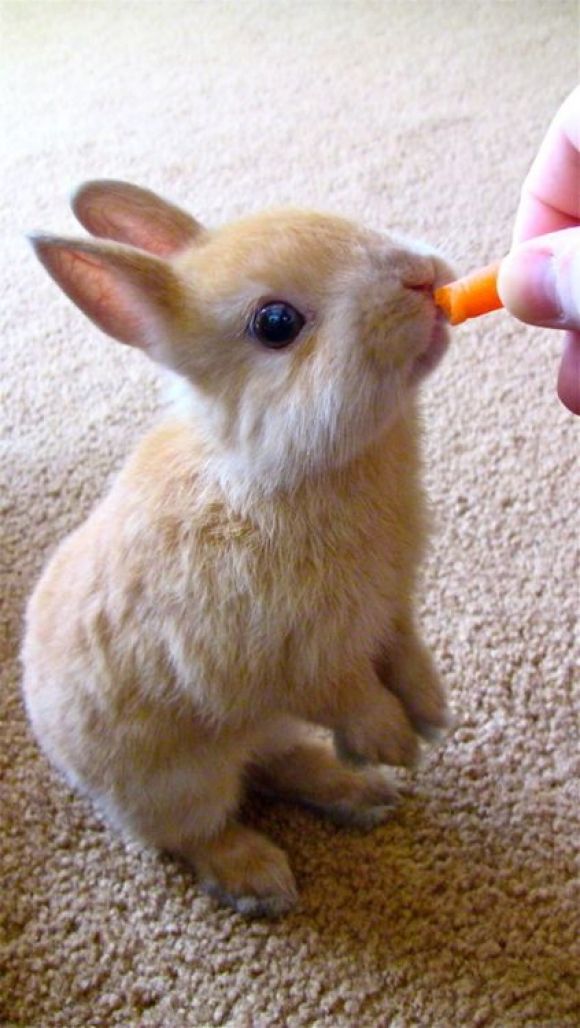
- Females become aggressive, lose the ability to reproduce.
- There are cases of cannibalism among individuals.
If the beginnings of these problems appear, reduce portions or remove flour from the diet.
Chalk is a safe mineral supplement providing calcium to the body. It can be used in powder form, in lump form and in mineral briquettes. Chalk is useful for the prevention of diseases of bone tissue.
Branches and acorns
Branches of trees and shrubs are used not only as food. Some are useful for the prevention of ailments.
So, for example, walnut branches remove parasites from the body, linden and willow - work as an anesthetic, birch - as a diuretic. Give them to rabbits infrequently, as needed.
Trees and shrubs whose branches can be used as permanent feeding include: .
Trees whose branches can be given to rabbits occasionally :
- Pear, rowan, oak, chestnut.

- Pine, juniper.
Do not use branches of bird cherry, lilac, elder, rosemary in the diet.
Another nutritious food for rabbits is acorns. You can feed them both green and dry. The norm of acorns per day for an adult is 50 g.
Introduce them into the diet gradually - first in the form of flour, as an additive to the main grain feed, and then as an independent complementary food. Rabbits love to chew on them.
For more information, read our article on how, when and what to feed rabbits.
Edible salt
Table salt is used for more than just seasoning. Chlorine ions contribute to the production of hydrochloric acid in the composition of gastric juice, and sodium ions are responsible for the transmission of nerve impulses.
Rabbits gnaw on wooden partitions in the cage due to salt deficiency. This indicates such problems:
- violation of metabolic processes;
- decreased productivity of offspring, increased number of miscarriages;
- slow growth of newborn animals;
- diseases of the gastrointestinal tract;
- water-salt imbalance and diseases associated with blood formation.
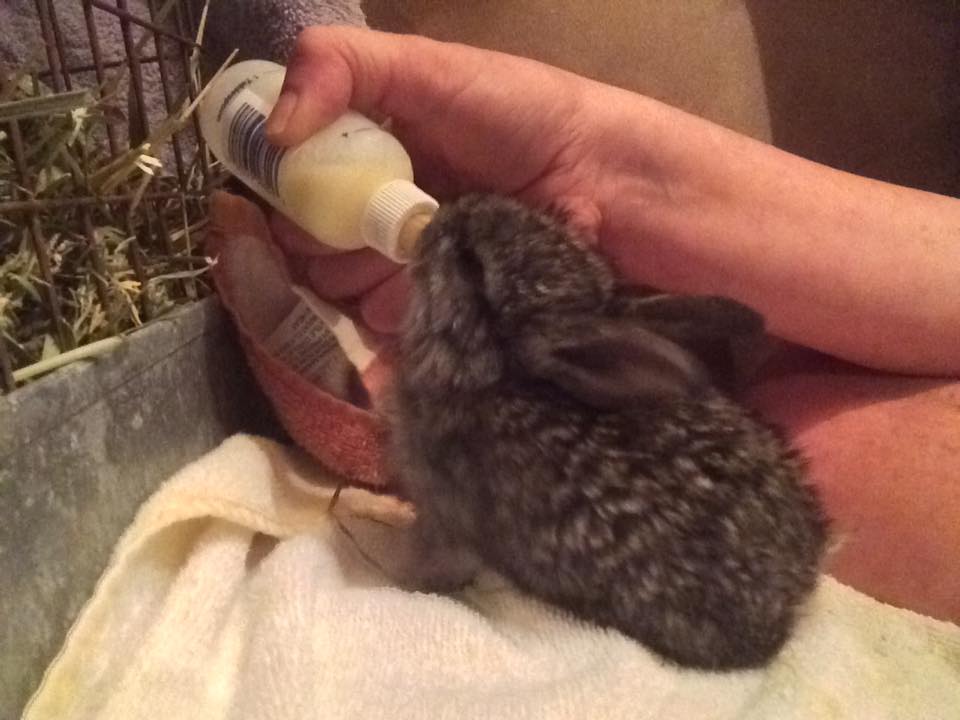
Edible salt is given together with chalk. For this, mineral briquettes are prepared. The following components are required:
- 500 g feed chalk;
- 500 g red clay flour;
- 300 g ground hardwood charcoal flour;
- 5 st. l. salt;
- 3 tbsp. l. fodder sulfur.
Mix ingredients with water until a thick dough is obtained. From it, fashion shapes the size of a matchbox. String them on the wire. Dry first in the shade and then in the sun. Fire it like clay in a kiln.
Place one in each rabbit cage. They themselves will learn to gnaw a briquette in the amount that their body requires.
Acidophilus
Rabbits are not very healthy, the gastrointestinal tract is their weak point. Gastrointestinal stasis is often found in these animals, when the stomach stops working and the individual dies.
Acidophilus is a complex of beneficial lactobacilli. It helps digest food in the large intestine and protects against harmful bacteria that can lead to bloating, diarrhea, and other problems.
This drug will also help when taking antibiotics, when the entire intestinal microflora is destroyed.
Caecotrophs are the primary feces of the rabbit. It has an oblong shape, often reminiscent of a bunch of grapes due to sticky spools. The color varies from light green to black. The smell is unpleasant, sour.
This feces is formed in a special compartment of the caecum, which is found only in lagomorphs. Therefore, do not confuse caecotrophs with ordinary feces.
Usually rabbits eat caecotrophs from the age of 20 days as soon as they leave the body. In this way, they re-absorb vitamins and minerals. Without this, the animals would suffer from beriberi.
If there are too many caecotrophs, the animal does not eat them, then you are overfeeding the rabbit with cereals. Remove grains from the diet for a couple of days, leaving water, branches and hay.
The second reason may be worms. Get rid of the parasites and everything will be back to normal.
Artificial feeding of rabbits has its positive and negative aspects.
The benefits include:
- Getting used to milk substitutes, rabbits are undemanding to eat.
- Good appetite leads to weight gain and growth of individuals.
- The diet is adjusted to the person and his capabilities.
Disadvantages of artificial feeding:
- Nutritional value, composition of vitamins and minerals in substitutes is much lower than in natural rabbit milk.
- Inability to transfer antibodies, which means weakened immunity of the offspring.
- Difficulty in nipple training.
- Baby rabbit may be injured while feeding.
- The constant presence of a person next to the kids for care and attention.
Baby rabbit care
The earlier the baby rabbits were left without a queen, the more complex care they need. The conditions of detention and the feeding regime require a great responsibility and dedication from a person.
Lighting and heat
Newborn rabbits require special care, attention should be paid to lighting and heat when rearing babies.
There must be a place in the cage where the sun's rays do not reach. Direct solar radiation is dangerous for animals. Daytime lighting should be dimmed, and it is recommended to turn off the lights at night.
Keep the rabbits warm. To do this, build a nest from the fluff of adult rabbits or put a heating pad in the cage. The optimum temperature is considered to be when a person’s hand is comfortable, and not hot.
Hygiene
Cleanliness in the care of rabbits is essential, because without immunity they are more susceptible to germs and bacteria.
Boil utensils and teats before use. Prepare the mixture before feeding, according to the instructions. Store milk in the refrigerator for up to 3 days.
Before feeding, wash your hands with fragrance-free soap and dry with a towel. After feeding, clean the babies from the remnants of food and bowel movements.
Abdominal massage
Bowel and bladder emptying requires special attention, because babies do not know how to cope with it.
Before feeding, the female licks the baby rabbit, pressing on the stomach with her tongue, moving from the navel to the hind legs. Thus, it causes the intestines and bladder to empty.
A person who substitutes a mother for rabbits should not forget about this procedure. Otherwise, the bladder will burst.
Before each feeding, massage the baby's belly with a damp soft cloth or piece of cotton wool.
This manipulation is completed when the offspring are over 14 days old.
In healthy rabbits, the belly is elastic and slightly convex. If it is sunken, then this is a sign of gastrointestinal problems.
In the video below, the breeder demonstrates how to massage the belly of a rabbit before feeding:
